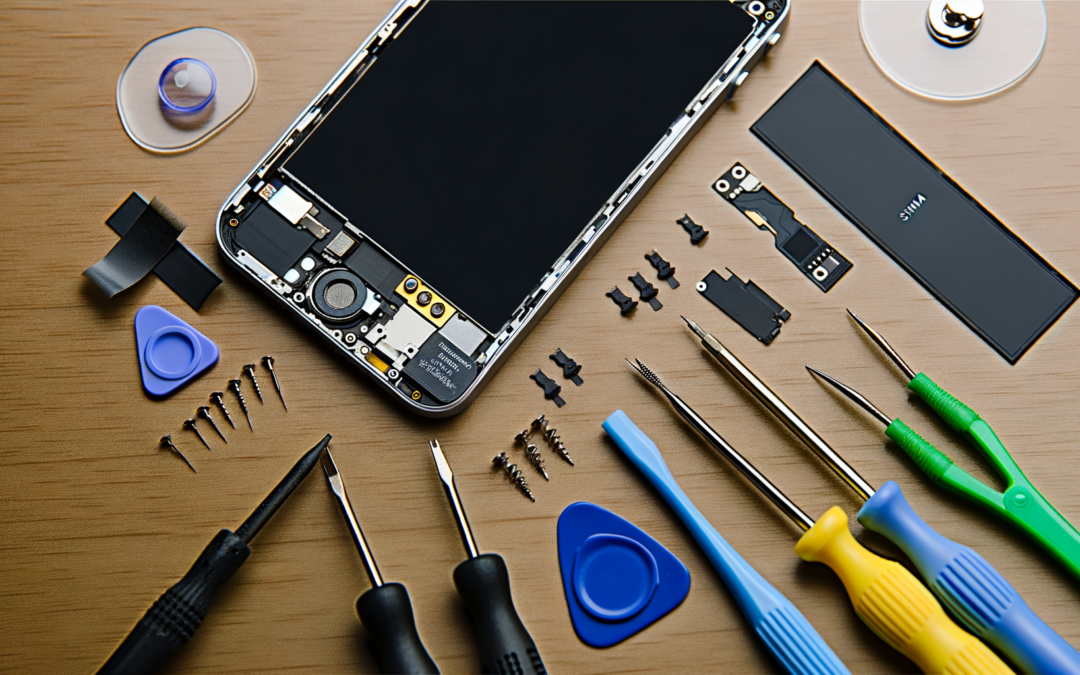The right to repair movement is gaining traction globally, emphasizing the importance of allowing consumers to fix their own devices. This article delves into the concept, with a focus on Apple’s iPhone and its impact on hardware repairability.
The Right to Repair Movement
Apple has long been known for its sleek design and innovative technology, especially with its flagship product, the iPhone. However, when it comes to hardware repairs, Apple has taken a more closed-off approach compared to other tech companies. Proprietary screws, software barriers, and limited availability of spare parts and repair manuals have made it increasingly difficult for consumers to fix their own devices.
Apple’s use of proprietary screws, such as the pentalobe screw, has been a major point of contention for consumers and repair professionals alike. These specialized screws require specific tools that are not easily accessible to the average person, discouraging DIY repairs. This strategy also makes it more challenging for third-party repair shops to access the inside of the device, forcing consumers to rely on Apple’s own repair services.
In addition to proprietary screws, Apple has implemented software barriers that can prevent third-party repairs. For example, with each new iOS update, there is a risk that non-Apple parts may not function properly or could even be disabled altogether. This not only hinders the repair process but also limits consumer choice in terms of where they can get their device fixed.
Furthermore, Apple has faced criticism for the limited availability of spare parts and repair manuals. While Apple has gradually started to offer repair manuals for certain products, they are often restricted to authorized service providers. This lack of transparency makes it difficult for consumers to have their devices repaired by independent repair shops, leading to higher repair costs and longer wait times.
Overall, Apple’s approach to hardware repairs has sparked a growing movement advocating for the right to repair. As consumers become more aware of the environmental impact of electronic waste and the importance of sustainability, the push for greater access to repair resources is gaining momentum. By addressing issues such as proprietary screws, software barriers, and limited availability of spare parts, Apple has the opportunity to lead the way in promoting a more sustainable approach to technology. As the right to repair movement continues to evolve, it will be interesting to see how Apple responds to the growing demand for greater accessibility and transparency in hardware repairs.
Apple’s Approach to Hardware Repairs
Apple’s Approach to Hardware Repairs
Apple has long been known for its sleek and innovative products, with the iPhone being one of its most iconic devices. However, the company’s approach to hardware repairs has sparked controversy and criticism over the years.
One of the key issues that have drawn the ire of consumers and advocates for the right to repair is Apple’s use of proprietary screws in its devices, including the iPhone. These specialized screws make it difficult for users to open up their devices and make repairs on their own, forcing them to rely on Apple or authorized repair shops for services.
In addition to proprietary screws, Apple has also implemented software barriers that prevent third-party repair shops from accessing certain diagnostic tools and software needed to effectively repair iPhones. This practice not only limits the options available to consumers for repairs but also stifles competition in the repair market.
Furthermore, Apple has faced criticism for its limited availability of spare parts and repair manuals for the iPhone. This lack of transparency makes it challenging for independent repair shops and consumers to access the resources needed to fix issues with their devices, leading to a reliance on Apple’s own repair services.
Overall, Apple’s restrictive practices when it comes to hardware repairs have fueled calls for change and have become a focal point in the broader right to repair movement. Advocates argue that easier access to spare parts, repair manuals, and diagnostic tools would not only empower consumers to repair their devices but also reduce electronic waste and promote sustainability.
As consumers become more aware of the environmental impact of electronic waste and the importance of sustainability, the demand for the right to repair is only growing stronger. By shining a light on Apple’s approach to hardware repairs, particularly for the iPhone, we can better understand the intersection of technology, consumer rights, and sustainability. It is crucial for companies like Apple to listen to these concerns and work towards creating a more repair-friendly environment for their products, ultimately benefitting both consumers and the planet.
Implications for Consumers and the Environment
Restricted repairability of devices, such as Apple’s iPhone, can have significant implications for both consumers and the environment. This limited repairability impacts consumers’ ability to maintain and prolong the lifespan of their devices, ultimately leading to increased electronic waste and potentially contributing to the cycle of planned obsolescence.
**Affordability of Repairs**:
One of the main issues with restricted repairability is the cost associated with getting your device fixed. When manufacturers like Apple control the repair process and restrict access to spare parts and repair manuals, it often leads to inflated repair costs. This can be burdensome for consumers, especially those who are on a tight budget or live in regions where repair services are not readily available. As a result, many consumers are forced to replace their devices rather than repair them, adding to the growing problem of electronic waste.
**Growth of Electronic Waste**:
The limited repair options for devices like the iPhone contribute to the ever-growing electronic waste problem. When consumers are unable to repair their devices or choose not to due to high costs, these devices often end up in landfills, leaching harmful chemicals into the environment. According to the Global E-waste Monitor, approximately 53.6 million metric tons of electronic waste were generated worldwide in 2019, with only 17.4% being recycled. The lack of repairability of devices like the iPhone undoubtedly contributes to this alarming statistic.
**Ethical Considerations of Planned Obsolescence**:
Planned obsolescence, the practice of designing products with a limited lifespan to encourage repeat purchases, is a contentious issue tied to restricted repairability. By making it difficult or costly to repair devices, manufacturers like Apple may inadvertently be pushing consumers towards buying new devices more frequently. This not only drives up consumer spending but also contributes to the depletion of finite resources and the generation of unnecessary electronic waste. Ethical considerations come into play when consumers are pressured to upgrade their devices when a simple repair could have extended the lifespan of the product.
Overall, the restricted repairability of devices like the iPhone has far-reaching implications for both consumers and the environment. As the right to repair movement gains traction, it is essential for manufacturers to reconsider their repair practices and embrace more repair-friendly design approaches. By promoting repairability, manufacturers can empower consumers to make sustainable choices, reduce electronic waste, and ultimately shape a more ethical and environmentally conscious tech industry.
The Future of Hardware Design and Repairability
Apple’s iPhone has been at the center of the right to repair debate due to its notoriously difficult repairability. However, as consumer demand for repairable and sustainable products grows, there is a shift towards more repair-friendly hardware design practices. This shift is not only driven by consumer advocacy but also by legislative efforts to promote repairability and reduce electronic waste.
**More Repair-Friendly Design Practices**
– Manufacturers are beginning to prioritize repairability in the design of their products, with a focus on modularity and ease of disassembly. This allows for components to be easily replaced or upgraded, extending the lifespan of the product.
– Designing products with standardized parts and components can also make repairs more accessible to consumers and third-party repair technicians. This reduces dependency on manufacturers for repairs and opens up the repair market to competition.
– Embracing design principles that promote repairability not only benefits consumers but also aligns with sustainability goals by reducing electronic waste and conserving resources.
**The Role of Legislation**
– In response to the growing demand for the right to repair, some governments have introduced legislation to enforce manufacturers to provide access to repair manuals, tools, and parts. These efforts aim to level the playing field for independent repair shops and empower consumers to choose where they get their devices repaired.
– By holding manufacturers accountable for the repairability of their products, legislation encourages more sustainable practices in the tech industry. It also promotes transparency and consumer rights in a market that has traditionally favored planned obsolescence.
**Influence of Consumer Advocacy**
– Consumer advocacy groups have been instrumental in raising awareness about the importance of the right to repair. By educating consumers about their repair options and pushing for legislative changes, these groups are driving a cultural shift towards sustainable consumption habits.
– Social media has played a crucial role in amplifying consumer voices and holding companies accountable for their environmental impact. Through grassroots campaigns and online petitions, consumers are demanding more sustainable products and repair practices from tech companies like Apple.
**Predictions and Implications**
– As more consumers prioritize repairability in their purchasing decisions, tech companies will be compelled to adopt more sustainable and repair-friendly design practices. This shift will not only benefit the environment by reducing electronic waste but also empower consumers to make informed choices about their devices.
– The tech industry is likely to see a rise in modular and easily repairable products, as manufacturers adapt to meet consumer expectations and comply with changing regulations. This trend towards repair-friendly design is set to shape the future of hardware production and consumer habits, paving the way for a more sustainable tech industry overall.
Conclusions
The right to repair is crucial for promoting sustainability and consumer rights. Apple’s stance on iPhone repairs highlights the debate between innovation and accessibility. As the movement grows, it will shape the future of hardware design and consumer empowerment.

